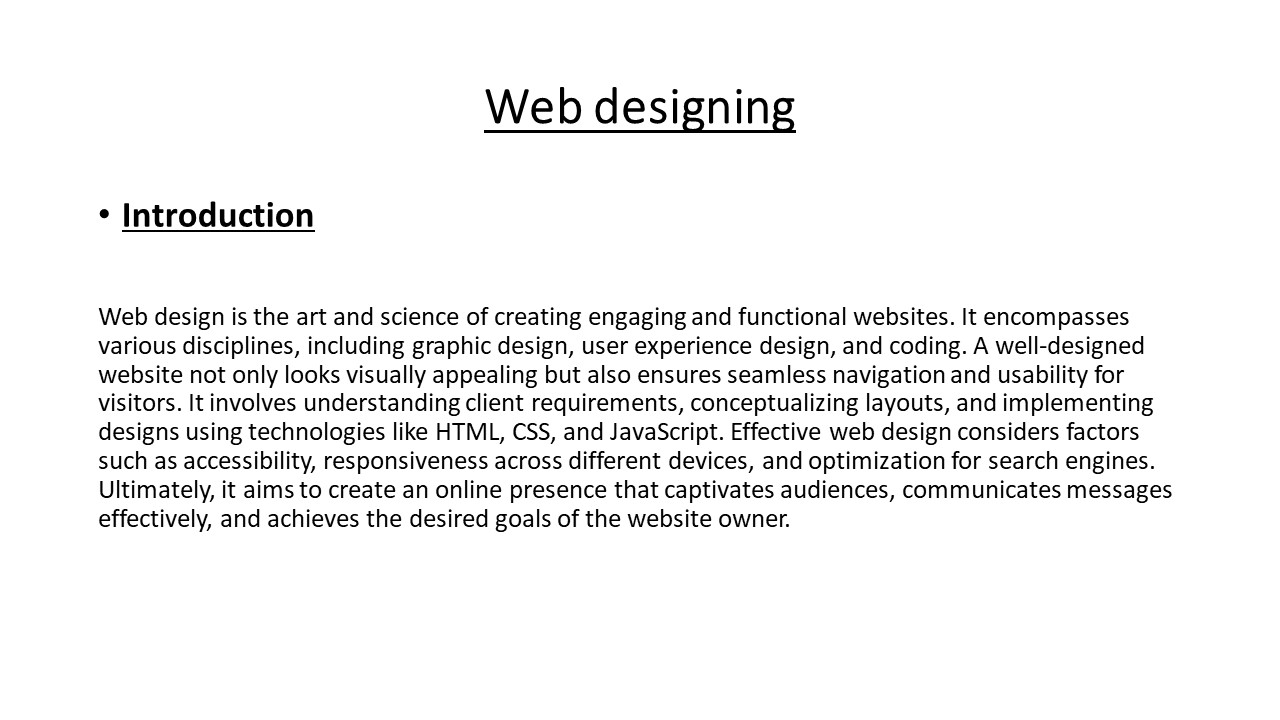web designing course in chandigarh - PowerPoint PPT Presentation
Title:
web designing course in chandigarh
Description:
A web designing course teaches the fundamental skills and principles needed to create visually appealing and functional websites. Students learn about HTML, CSS, and JavaScript, the building blocks of web design, as well as design principles, user experience (UX) design, and responsive design techniques to ensure websites look great on any device. – PowerPoint PPT presentation
Number of Views:0
Date added: 13 May 2024
Slides: 11
Provided by:
amarjeet01
Category:
How To, Education & Training
Tags:
Title: web designing course in chandigarh
1
Web designing
- Introduction
- Web design is the art and science of creating
engaging and functional websites. It encompasses
various disciplines, including graphic design,
user experience design, and coding. A
well-designed website not only looks visually
appealing but also ensures seamless navigation
and usability for visitors. It involves
understanding client requirements,
conceptualizing layouts, and implementing designs
using technologies like HTML, CSS, and
JavaScript. Effective web design considers
factors such as accessibility, responsiveness
across different devices, and optimization for
search engines. Ultimately, it aims to create an
online presence that captivates audiences,
communicates messages effectively, and achieves
the desired goals of the website owner.
2
Image of web designing
3
Types of web designing
- Static Web Design Basic websites with fixed
content, suitable for simple informational
purposes. - Dynamic Web Design Websites with dynamic content
that can change based on user interaction or
database-driven updates. - Responsive Web Design Designs that adapt
seamlessly to different screen sizes and devices,
ensuring a consistent user experience across
platforms. - Mobile-First Design Prioritizing design for
mobile devices, given the increasing use of
smartphones and tablets for web browsing. - Single Page Web Design Websites that present all
content on a single page, offering a streamlined
and immersive user experience. - Flat Design Minimalistic design approach
characterized by clean lines, simple shapes, and
vibrant colors, often used for fast-loading and
modern-looking websites. - Material Design Google's design language
emphasizing depth, motion, and real-world
metaphors, providing a cohesive and intuitive
user experience. - Parallax Web Design Creating a 3D effect by
moving foreground and background elements at
different speeds, adding depth and interactivity
to the website.
4
Image of types of web designing
5
Advantages of web designing
- Global Reach Websites allow businesses and
individuals to reach a global audience, breaking
down geographical barriers and expanding their
market reach. - Accessibility Well-designed websites ensure
accessibility for users with disabilities,
complying with web accessibility standards and
providing equal access to information and
services. - Brand Identity Through cohesive design elements
such as colors, typography, and imagery, web
design helps establish and reinforce brand
identity, fostering recognition and trust among
users. - User Engagement Engaging and user-friendly
designs enhance the overall user experience,
encouraging visitors to explore the website,
interact with its content, and take desired
actions. - Search Engine Visibility Effective web design
practices, such as proper coding, optimized
content, and mobile responsiveness, contribute to
improved search engine rankings, increasing
visibility and driving organic traffic to the
website. - Credibility and Trust Professionally designed
websites convey credibility and trustworthiness,
instilling confidence in visitors and encouraging
them to engage with the content or make
purchases.
6
Image of advantages of web designing
7
Features of web designing
- User Interface (UI) Design Designing the layout,
navigation, and visual elements of a website to
create an intuitive and visually appealing user
interface. - Responsive Design Ensuring that websites adapt
seamlessly to different screen sizes and devices,
providing a consistent user experience across
desktops, laptops, tablets, and smartphones. - Cross-Browser Compatibility Designing websites
to perform consistently across various web
browsers such as Chrome, Firefox, Safari, and
Edge, ensuring compatibility with different
browser technologies and versions. - Accessibility Implementing design principles and
coding techniques to make websites accessible to
users with disabilities, complying with web
accessibility standards such as WCAG (Web Content
Accessibility Guidelines). - Content Management System (CMS) Integration
Integrating CMS platforms like WordPress, Joomla,
or Drupal to facilitate content creation,
editing, and management, enabling non-technical
users to update website content easily. - Visual Design Elements Incorporating visual
elements such as images, graphics, videos, icons,
and animations to enhance the aesthetic appeal
and engagement of the website. - Navigation Design Designing intuitive navigation
menus, breadcrumbs, and site maps to help users
easily find information and navigate through the
website's pages.
8
Scope of web designing
- Business Websites Designing websites for
businesses to showcase products, services, and
brand information. - E-commerce Platforms Creating user-friendly
interfaces for online buying and selling. - Responsive Design Ensuring websites adapt
seamlessly to various devices for optimal user
experience. - Content Management Systems (CMS) Customizing
platforms like WordPress for easy content
management. - Web Applications Designing interactive
applications for social networking, e-learning,
and more. - User Experience (UX) Design Focusing on
usability and satisfaction for intuitive website
navigation. - Search Engine Optimization (SEO) Implementing
practices to improve website visibility and
ranking. - Web Accessibility Ensuring websites are
accessible to users with disabilities. - Graphic Design and Visual Branding Creating
visually appealing designs that reflect brand
identity. - Freelancing and Entrepreneurship Opportunities
for independent work or starting web design
businesses.
9
Salary package
- Web Designer Salaries in IndiaThe average salary
for Web Designer is ?1,36,435 per month in the
India. The average additional cash compensation
for a Web Designer in the India is ?1,15,452,
with a range from ?31,323 - ?1,86,522.21
10
Thank you
- Visit our website
- https//excellenceacademy.co.in/web-designing-cour
se-in-chandigarh/ - Contact us on 9317788822

